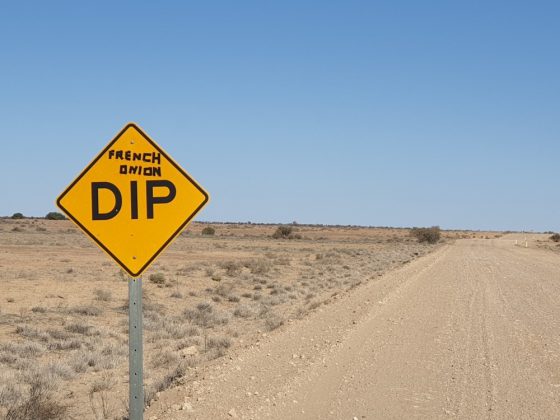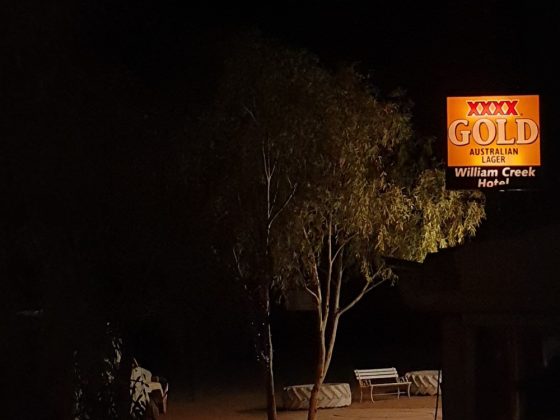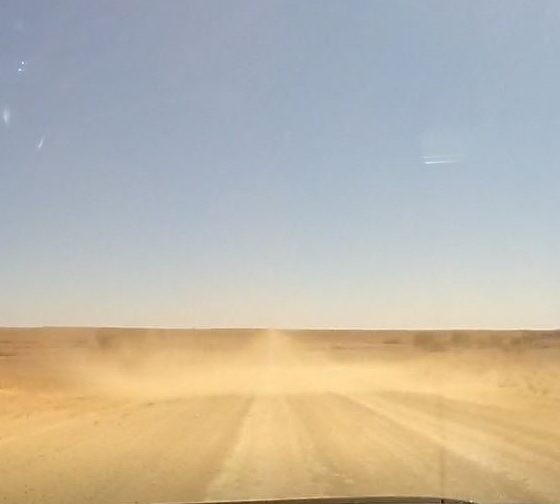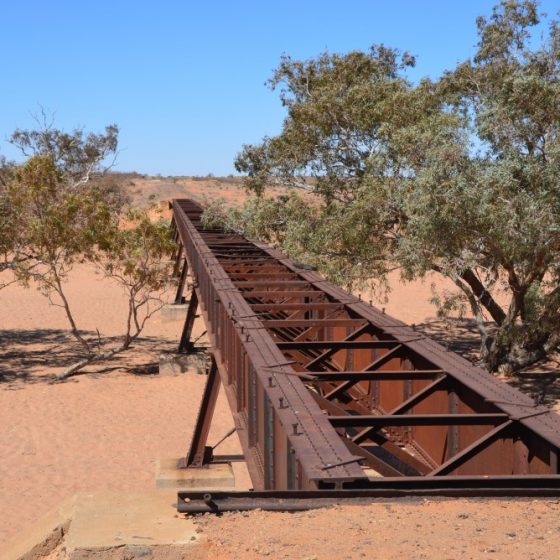
Day 31 – Coward Springs
My first day on the Oodnadatta Track. My plan is to reach Oodnadatta in three days with two overnight stops at Coward Springs and William Creek. And you guessed it, it will be all dirt for the 405 kilometre trip.
Travelling as I do on these outback dirt roads I should reach Coward Springs in around three hours; this includes stopping at all the points of interest, of which there are many on this stretch. The first being the Mutonia Sculpture Park. There is so much written about this roadside artwork.
“From a distance, as you travel along the Oodnadatta Track from Marree, your eyes catch a glimpse of something unusual on the horizon. They look like crosses from a distance, but as you drive closer, the vista becomes clearer and then you are here, at a truly modern day outdoor art gallery… the Mutonia Sculpture Park. This unique attraction stands like a statement, in the harsh arid outback. Created by Robin ‘Mutoid’ Cooke, a former mechanic that became an artist many years ago. All his works are created from recycled rubbish.”
Considering I had plenty of time to get to Coward Springs today I had breakfast and coffee at the Oasis Roadhouse. This also gave me a chance to say goodbye to the staff and the friends that I made during my stay in Marree.
Late yesterday afternoon I noticed the wind changed to a northerly, big change from the last 30 odd days of those cold southerlies. It warmed up quite quickly on the drive.
About 30 kms from Marree I got a glimpse of the first piece of sculpture. It was two aeroplanes sticking up in the air. Even though the piece (Plane Henge) is an absolute stand out, my favourite piece of all the art was the (Spinning Car). Every 4×4 vehicle, tour bus on the road this morning and myself have stopped to look at this. What a strange display. Unbelievable in the sense of why, in the middle of nowhere.
Lots of old Ghan Railway siding ruins from yesteryear still standing. Some are used for camping, some are wrecks. The Oodnadatta track follows the old Ghan Railway line all the way to Oodnadatta.
Coward Springs Campground was once a station on the old Ghan Railway line. The site was constructed in 1888 and abandoned before the line was closed in 1980. Greg Emmett and Prue Coulls have been residing here since 1991. They have built facilities, planted hundreds of native trees, restored the heritage buildings and much more.
I pulled into Coward Springs just before lunch, paid my camping fee – $15.00/person a night. The campsites are in the shade, sheltered by many of the historic trees including date palms. There are toilet and shower facilities which are built from recycled railway materials with some surprising details. The showers are fired by an old donkey system for the campers.
It felt a bit 4 star camping. Each site is raked and cleaned every day for new campers, like me. And a bush camp with the comfort of toilets and showers plus attractions such as a ‘natural spa’ and a museum (open April to late October) that make it very comfortable.
First things first, change into my boardies and off to the spa. I can set up the tent later in the afternoon. This is truly an oasis in the outback.
Next to the spa are three of the original Date palms from the Ghan days. This was a former Ghan railway water point. I visited the museum and found why the railway went this way.
“The Ghan railway track follows a traditional Australian Aboriginal trading route. It was a well-trodden trading route used for thousands of years, extending to northern Australia. Water could be found along the way. Along the Track are numerous springs feeding water from the Great Artesian Basin, the most accessible examples being the mound springs near Coward Springs (now in Wabma Kadarbu Mound Springs Conservation Park). Later, because of the availability of water, the route was chosen for the steam-train powered Central Australia Railway, the original route of The Ghan.”
Camp setup and dinner time. Tonight I would have ‘Chunky Chicken’, a nice change from the ‘Cattleman’s Beef Stew’……ha. I bought some oranges from Marree when I left this morning, oh….. how good are they to eat (dessert).
All fed and cleaned up, off to bed and watch the stars. Again, as usual the stars are brilliant. I got a couple of night camera shots. Bit cold sleeping again and the ground seems to be getting harder, or maybe that’s me finding it harder every day, ha.
Day 32 – William Creek
‘DON’T JUST TELL YOUR CHILDREN ABOUT THE WORLD, SHOW THEM’
A little saying I once heard! I hope all the pictures are doing just that.
I got up early before sunrise and walked the wetlands. There were no animals around, flies not out yet but the mosquitoes are still about. No hurry in heading off again today as I only have 74 kilometres to William Creek. This is the headquarters of Wrightsair (same company I flew with at Marree) and if I got there before lunch I could do a flight over the Anna Creek Painted Hills.
I stopped at a few of the ruins (railway sidings) on the way. The road was dreadful, never ending rocks, corrugations and sand. With the exception of the last 10 or so kilometres before William Creek. The road had been graded and it was like a highway, no joke. I learnt later that the S.A. Tourism Minister was in town and was to be driven on that section of road. No, I will not comment on that at all.
I arrived in William Creek just on lunch time. The place is so small (population 12), not a town as such, it’s called a township. It might well be the smallest town in Australia. It consists of a hotel (The 1887 pub was in the beginning a support station for camel drivers working on the Overland Telegraph Line), caravan park and the Wrightsair office. The William Creek Hotel is absolutely magnificent, it has the bar (dah), a rather large food hall which is surrounded by historical things. I ordered some lunch and it was fabulous. During lunch I read some details of the property surrounding William Creek because, well, I would be flying over it later this afternoon. I decided to stay the night here.
“Anna Creek Station has an area of 23,677 square kilometres (5,851,000 acres) which is slightly larger than Israel. It is 1,977,000 acres (8,000 km2) larger than its nearest rival, Alexandria Station in the country’s Northern Territory. It is over seven times the size of the United States’ biggest ranch, King Ranch in Texas, which is 825,000 acres (3,340 km2). As of 16 December 2016, the station is owned by the Williams Cattle Company, a family business that bought Anna Creek from S. Kidman & Co, doubling their total area held under pastoral leases. The nearest township is William Creek (which is surrounded by the Anna Creek station), but the nearest town for freight is Coober Pedy.”
I was lucky to get the last seat on the afternoon flight over the Anna Creek Painted Hills. It was so worth it, up in the air is where you can truly see the vastness of and not just these large cattle properties people talk about but our Australian Outback. I look out the aircraft to my left and to my right and wondered how the Aborigines walked this land and survived. I didn’t see any water during the entire flight and every one of the property dams we spotted was completely dry.
“The Anna Creek Painted Hills is a spectacular and recently discovered section of the pristine Breakaways country in the far north of South Australia. Breakaway country appears around Coober Pedy, Oodnadatta, Copper Hills, Arckaringa Hills, William Creek and Evelyn Downs. It is a rocky outcrop of large and small hills, which emerge suddenly out of a flat, desert landscape. The area can only be accessed by air, due to its fragility and natural beauty.”
No camping meal for me tonight, I’m joining a group from Queensland traveling in the opposite directions to me (down to Marree and then to Melbourne) here in the long dining room at the Hotel. It was great to share our experiences of the road ahead for each other. They intend to stop at Coward Springs, it’s only $2 for a day visit to the spa before staying at Marree. They liked the idea of the Caravan Park Camp Kitchen night at Marree.
A few more campers joined our table. We ordered our meals and drinks and in no time the meals were on our table. The meals were absolutely fabulous. I still stop and think about getting their food supplies (grocery shop) for the hotel, it just amazes me – and to think it is mostly trucked in from Adelaide.
Bit of a late night for me. Not really used to that at all. I had a great night with those fellow travellers.
Day 33 – Oodnadatta
I had been informed that Oodnadatta only had Optus service. Just unbelievable, no Telstra. This will be the fifth town that has no Telstra mobile service. Not a happy traveller. Oh well, cop it and use my phone card and the Telstra phone box to ring family.
Again I had all day to drive the 204kms to Oodnadatta so I decided to have breakfast at the pub. While I was cooking my toast I was told that Oodnadatta now has Telstra mobile service, it was turned on, on the 26th July this year. What great news. One of the travellers showed me a photo of the handwritten sign in the Oodnadatta Post Office. Now Kenny Mac is a happy traveller.
Today’s trip is something I have been looking forward to for a long time. I read on the 16th January this year that Oodnadatta’s temperature reached 47.7°C. And it is often said that it is one of the hottest and driest towns in Australia. It also has the hottest PINK roadhouse in the country.
The road was again the same as the previous few days getting to William Creek. Lots to see on the way, Duff Creek Bridge, Edward Creek, Peak Creek, Alegbuckina Railway Bridge (still standing) and North Creek. As I drove north the old Ghan railway track could be seen. Lots of old sleepers still on or beside the track and every now and then I could see remnants of the Overland Telegraph Line.
I stopped at the Alegbuckina Railway Bridge for a break and bite to eat. This bridge is a piece of engineering marvel, tad rusty but still standing. The track off the main road right up to the bridge was well warn, lots of travellers have come close to see it. This metal structure is 588 metres in length. I climbed up the now sand dune to the old track and looked down the bridge in wonderment. It was built in the early 1900s across dirt, desert and sand dunes, wow.
Looking out over the vast land eating my last orange I knew that from Oodnadatta I would turn to the south west and head for home. I wasn’t going to attempt the Mt Dare bulldust that Kevin told me about. I felt a little sad for a moment, and thought, I will cycle this Oodnadatta track one day.
I get my motivation from other venturers who have what I call ‘speed bumps’, get over them and continue on with plan B, or more if needed. I read this article in the early hours while camping in my tent at Coward Springs.
“Harry Dutton was a wealthy landowner near Kapunda. With Murray Aunger a talented mechanic and motoring enthusiast, he decided to demonstrate the practicality of the motor car for outback travel by driving from Adelaide to Darwin. He bought a 3.7 litre, 20 HP Talbot which he christened Angelina. He and Aunger left Adelaide from King William Street, near the General Post Office, on 25 November 1907. The Observer reported that ‘Mr Dutton took the seat at the steering pillar, and when the clock boomed out the noonday hour the car was set in motion to the accompaniment of hearty cheers from those present.’
By Christmas they were near Barrow creek on the way to Tennant Creek with about three quarters of the journey completed. But the wet season had begun, and in attempting to free their bogged car, a pinion in the back axle broke. The spare had been used earlier, and without a replacement they had to abandon the journey. They covered the car, making it as weatherproof as possible and set out for Oodnadatta on foot. Joining up with a camel train, they returned to Oodnadatta where they caught the train back to Adelaide.
In 1908 Dutton bought another Talbot – nicknamed 474 after its registration number. With the experienced gained in 1907 he specified a more powerful engine, and a lower axle ratio. The expedition left earlier – on 30 June 1908 – to avoid the wet season.
Some days they were able to travel more than 100 kilometres, but on others the harsh conditions limited them to as few as 16 kilometres. During the journey they experienced gibbers, rocky gorges, rivers, sandhills and bushfire. Mechanical problems were limited to punctures and broken leaf springs. They found Angelina, none the worse for wear, except the local wildlife had devastated the interior. After repairs to Angelina, the two cars proceeded. Finally, on the afternoon of 20 August 1908, they drove into Darwin after 51 days on the road.” Pictures of the two vehicles from the web.
I thought “I’ll be back”. Packed up my lunch stuff and headed off to Oodnadatta. About 15kms from town my phone started to ping, I had service, what a nice change. I rang the family (hands free) while I was driving and in no time at all I was at the fuel bowser in the driveway of the ‘The Pink Roadhouse – Gateway to the Simpson Desert’. It was 1:30pm and 36°C with a windy northerly.
I set up camp and found that they had washing facilities. Yahoo………washed all my clothes from the last three days ready for my journey home, 2,941kms 4 days. I’ll walk and visit all the tourist and historic places tomorrow.
Cheers Kenny Mac

















































